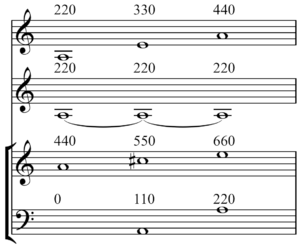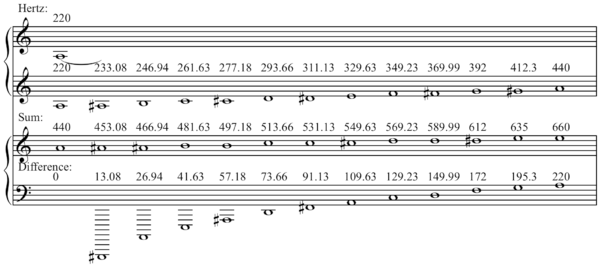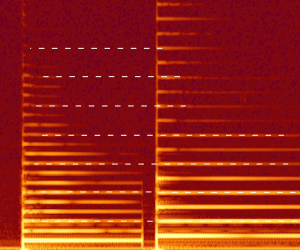Combination tone

A combination tone, also called a sum tone or a difference tone (also occasionally resultant tone), can be any of at least three similar psychoacoustic phenomena. When two tones are played simultaneously, a listener can sometimes perceive an additional tone whose frequency is a sum or difference of the two frequencies. The discovery of some of these phenomena is credited to the violinist Giuseppe Tartini, and so the tones are also called Tartini tones.
Explanation
One way a difference tone can be heard is when two tones with fairly complete sets of harmonics make a just fifth. This can be explained as an example of the missing fundamental phenomenon.[1] If  is the missing fundamental frequency, then
is the missing fundamental frequency, then  would be the frequency of the lower tone, and its harmonics would be
would be the frequency of the lower tone, and its harmonics would be  etc. Since a fifth corresponds to a frequency ratio of 2:3, the higher tone and its harmonics would then be
etc. Since a fifth corresponds to a frequency ratio of 2:3, the higher tone and its harmonics would then be  etc. When both tones are sounded, there are components with frequencies of
etc. When both tones are sounded, there are components with frequencies of  etc. The missing fundamental is heard because so many of these components refer to it.
etc. The missing fundamental is heard because so many of these components refer to it.
The specific phenomenon that Tartini discovered was physical. Sum and difference tones are thought to be caused sometimes by the non-linearity of the inner ear. This causes intermodulation distortion of the various frequencies which enter the ear. They are combined linearly, generating relatively faint components with frequencies equal to the sums and differences of whole multiples of the original frequencies. Any components which are heard are usually lower, with the most commonly heard frequency being just the difference tone,  , though this may be a consequence of the other phenomena. Although much less common, the following frequencies may also be heard:
, though this may be a consequence of the other phenomena. Although much less common, the following frequencies may also be heard:
For a time it was thought that the inner ear was solely responsible whenever a sum or difference tone was heard. However, experiments show evidence that even when using headphones providing a single pure tone to each ear separately, listeners may still hear a difference tone. Since the peculiar, non-linear physics of the ear doesn't come into play in this case, it is thought that this must be a separate, neural phenomenon. Compare binaural beats.
Heinz Bohlen proposed what is now known as the Bohlen–Pierce scale on the basis of combination tones,[2] as well as the 833 cents scale.

Resultant tone
In pipe organs, a resultant tone is the sound of a combination of organ pipes that allows the listener to perceive a lower pitch.[3]
This is done by having two pipes, one pipe of the note being played, and another harmonically related, typically at its fifth, being sounded at the same time. The result is a pitch at a common subharmonic of the pitches played (one octave below the first pitch when the second is the fifth, 3:2, two octaves below when the second is the major third, 5:4). This effect is useful especially in the lowest ranks of the pipe organ where cost or space could prohibit having a rank of such low pitch. For example, a 64' pipe would be costly and take up at least 32' of space (if capped) for each pipe. Using a resultant tone for such low pitches would eliminate the cost and space factor, but would not sound as full as a true 64' pipe.
This effect is most often used in the lowest octave of the organ only. It can vary from highly effective to disappointing depending on several factors, primarily the skill of the organ voicer, and the acoustics of the room the instrument is installed in.
See also
References
- ↑ Beament, James (2001). How We Hear Music, . The Boydell Press. ISBN 0-85115-813-7.
- ↑ Max V. Mathews and John R. Pierce (1989). "The Bohlen–Pierce Scale", p.167. Current Directions in Computer Music Research, Max V. Mathews and John R. Pierce, eds. MIT Press.
- ↑ James Ingall Wedgwood (1907). A Comprehensive Dictionary of Organ Stops: English and foreign, ancient and modern: practical, theoretical, historical, aesthetic, etymological, phonetic (2nd ed.). G. Schirmer. p. 1.
Further reading
- Adrianus J. M. Houtsma, Julius L. Goldstein, "Percepetion of Musical Intervals: Evidence for the Central Origin of the Pitch of Complex Tones", Massachusetts Institute of Technology, Research Laboratory of Electronics, Technical Report 484, October 1, 1971.
External links
- Titchener Difference Tones Training
- Difference tones on the harmonica
- Pitch Perception Lecture Notes
- Tartini computer program. Uses combination tones for pitch recognition. If certain intervals are played in double-stop, the program can display its Tartini-tone.
- http://www.organstops.org/r/Resultant.html
| ||||||||||||||||||||||||

